MUSCULO-SKELETAL RISK SCREEN
The musculo-skeletal risk factor profile looked at a range of
parameters including mobility, strength and flexibility and whether people
are training to keep themselves strong and flexible. The musculo-skeletal
risk factor profile is comprised of the following test items:
Current musculo-skeletal condition
Closeness to ideal weight
leg strength
Abdominal strength test
Upper body strength test
Flexibility
Ability to sit up straight with legs crossed
Shoulder function
Strength training behaviour
Flexibility training behaviour.
The 'pass mark' for each individual test item is 7/10. The
'pass mark' for the test overall is 70/100.
A score of 70% is attainable by those who have a regular and systematic training program.
Those scoring less than 70 are not doing sufficient in the way of strength and flexibility exercises. They are therefore exposing themselves to a high risk of musculo-skeletal dysfunction. (It would be bizarre for a workplace to offer to pay the rehabilitation costs of people who were not keeping themselves strong enough or flexible enough to do their job without succumbing to musculo-skeletal dysfunction, wouldn't it?)
|
|
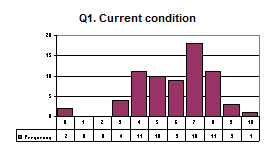 |
|
 |
|
|
A smaller than normal number of people are
experiencing constant pain and discomfort. In a corporate setting we'd
recommend that those scoring less the 6 need to be required
attend a prehab/rehab program, for their own benefit and that of
the organisation. |
|
As
an estimate, at least 25% of people were 20Kg over weight, some a
great deal more than that. Being over weight is a
significant risk factor in the development of joint and muscle
pain. |
|
|
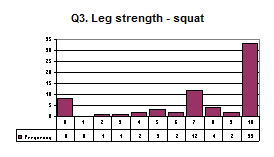 |
|
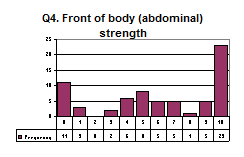 |
|
|
Relatively speaking, leg strength was good.
Having said that, 8 people couldn't squat down and up once in 60
seconds and close to 25% of people could be classed as
performing poorly. |
|
40%
of people failed this test. |
|
|
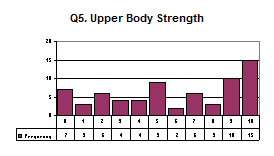 |
|
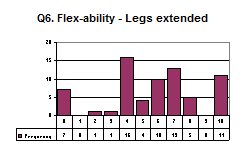 |
|
|
Around 40% of people failed this test. One of the best predictors of risk of lower back
pain is the ability to do pressups. |
|
This is a good result. Only 9 people couldn't touch their toes. Lower back pain goes with
poor hamstring flexibility. |
|
|
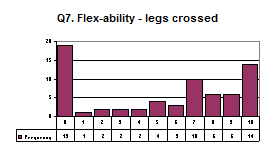 |
|
 |
|
|
More than 30% of people couldn't sit up straight with legs
crossed and hands clasped behind their back, without falling over. A
major cause of lower back pain is tight buttock muscles. |
|
With a relatively few exceptions, shoulder function was good.
Poor shoulder function can usually be restored to good with an intensive
strength and flexibility training program. |
|
|
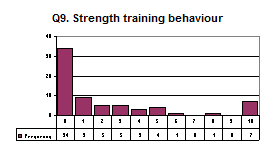 |
|
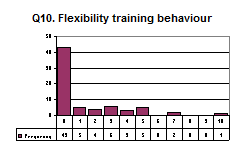 |
|
Its always the case, few people have a regular strength and
flexibility program. The organisation needs to put in train a regular
and systematic training program, on site, that includes
1. specialist prehab and rehab sessions for
those at serious risk and those already dysfunctional and on
compo
2. daily strength and flexibility sessions
in the workplace for everyone. |
|
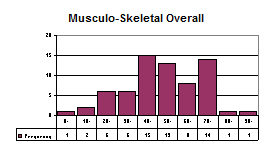
|
|
Average score: 49.
Not a good result. This graph show
why some people are experiencing pain. Too many people do not
have the strength and flexibility training program needed to keep their musculo-skeletal system in good
condition. There is a strong case of the group to implement an
obligatory strength and flexibility program for those who scored
less than 60 in this profile. |